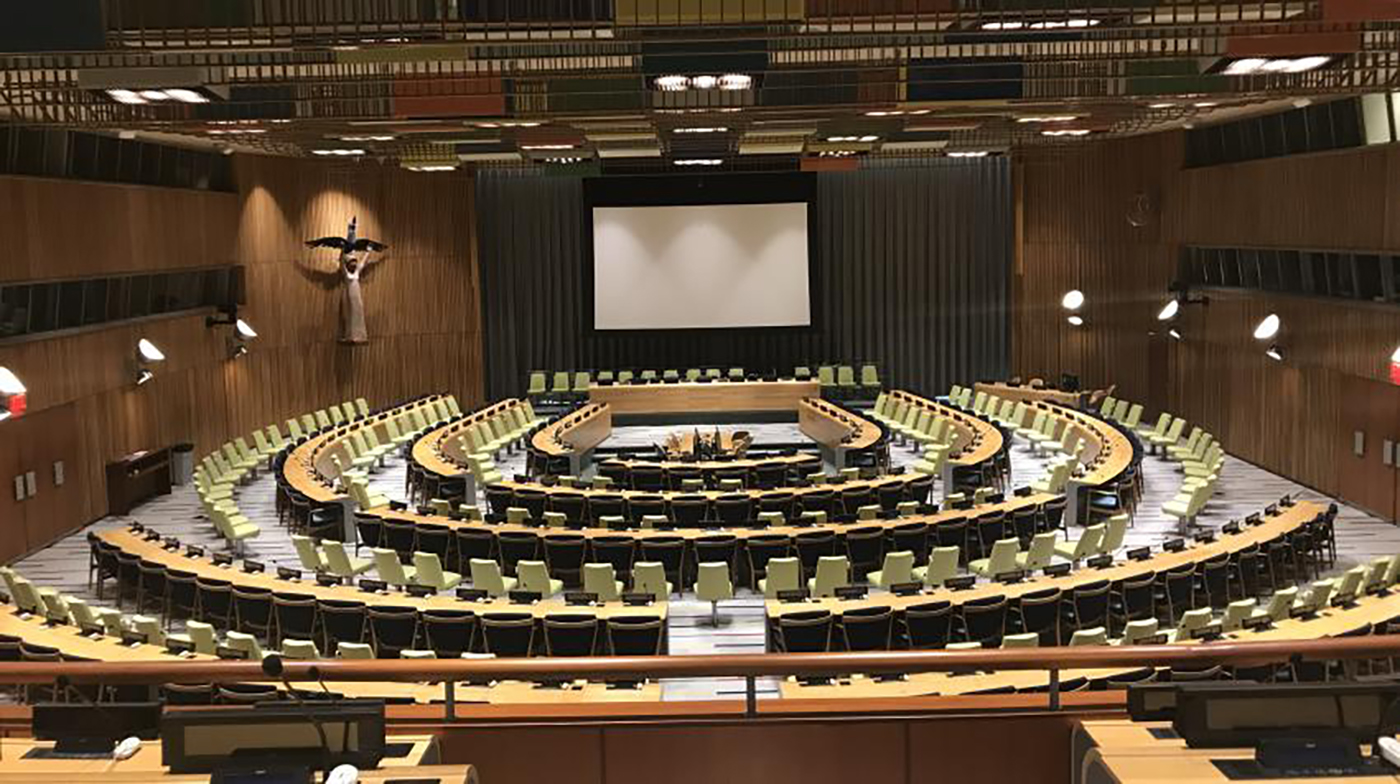Report on United Nations Summits
September 5, 1997
at XLI Congress
Union Internationale Des Avocats
International Association of Lawyers
Philadelphia, PA
By Jonathan Granoff
United Nations Representative of Lawyers Alliance for World Security
and
Board Member Global Dialogue Institute
Introduction
Colleagues, friends, ladies and gentleman, how good to be with an international community. Yet, “international” still fixes our identities with nations. I believe that for many of us our identity and sense of ethical accountability has already become global and planetary and our language will catch up soon. We are part of one human family with numerous layers of political identities, ranging from local to global.
Although not formally recognized as such, global ethical dialogue has been taking place in the context of the UN since its inception. In the 1990’s global ethical dialogue accelerated rapidly and dramatically with the UN’s convening of a series of world summit conferences. These conferences assumed that human suffering can and must be addressed globally and that world security can be understood in the context of human rights and sustainable development.
These conferences addressed the increasing disparity of wealth between the developed and underdeveloped world highlighted by the fact that between 25 and 30 thousand children starve to death each day, and over a billion and a half people live with uncertainty as to whether they will have enough calories in the next few days to survive;
These conferences addressed the global aspects of our environmental crisis highlighted by the fact that a hydrofluorocarbon molecule emanating from a refrigerant in Chile recognizes no national boundaries in its destruction of the fragile ozone layer.
The inter-relatedness between such issues as environmental protection and the well being of children, unemployment and crime, and population growth and the rights of women became apparent. We have begun to recognize that so many of our problems are global and affect us all: organized crime, trafficking in children and drugs, the AIDS epidemic, protecting biological diversity, ozone depletion, malnutrition, illiteracy, inadequate housing, unemployment, racism, ethnic and religious strife, violence against women, massive violations of human rights, the extraordinary expenditures in conventional weapons, and the threats posed by weapons of mass destruction.
These conferences provided a forum where civil society partnered with governments. Each conference marked the culmination of months of consultations among member states, non-governmental representatives, and United Nations experts who reviewed vast amounts of information and shared knowledge and experience. Each conference forged agreements on specific issues and commitments from member states. Imagine the difficulty of obtaining consensus on anything amongst so many nations! Significantly, non governmental organizations organized caucuses around themes such as values, peace, women, and the environment, often raising moral perspectives and decrying lack of commitment by governments.
To those of us, like myself, who participated in these conferences, it became clear that human security no longer is coterminous with the security of sovereign states. Human security is global security. This calls for a higher ethical perspective and for a global dialogue. These summits can be understood in the context of that dialogue.
The Children’s Summit
Conference: World Summit for Children (WSC)
United Nations, New York, 29-30 September 1990
Informal name: The Children’s Summit
Number of Governments participating: 159, including 71 heads of Government
Conference Co-chairmen: Brian Mulroney, Canada, and Mussa Traore, Mali
Organizers: The six initiating countries (Canada, Egypt,Mali, Mexico, Pakistan,Sweden) with the support of UNICEF and other UN agencies under the auspices of the United Nations Secretary-General
Principal themes: Goals for the year 2000 for children’s health, nutrition, education, and access to safe water and sanitation
NGO presence: 45 non-governmental organizations participated in the Summit
Resulting document: World Declaration and Plan of Action on the Survival, Protection and Development of Children.
Follow-up mechanisms: Mid-decade review, with Secretary-General’s progress report presented at the 1996 General Assembly session on the anniversary of the Children’s Summit; IN Inter-Agency Task Force, the Joint Committee on Health Policy and the Joint Committee on Education; National Programmes of Action for Children within each national Government; UNICEF is the lead UN agency
Appropriately, the series of summits began with The Children’s Summit at the United Nations in New York in 1990. Its principal theme set forth goals to be reached by the year 2000 for children’s health, nutrition, education and access to safe water and sanitation. Many of these commitments are being met. Already 89 countries have reached the end decade target of over 90% immunization coverage, and the achievement of the goal of the eradication of polio by the year 2000 is in sight. There has been a dramatic improvement in the management of diarrhea saving the lives of at least a million children annually. The program for iodine deficiency control has led to over 1.5 billion more people consuming iodized salt in 1995 than in 1990, and as a result 12 million infants are protected from mental retardation each year. The population without access to safe drinking water has fallen by about one-third since 1990 helping in excess of a billion people. Also, there has been major progress in meeting the mid decade goal for the promotion of breast feeding.
The Earth Summit
Conference: United Nations Conference on Environment and
Development (UNCED)
Rio de Janeiro, 3-14 June 1992
Informal name: The Earth Summit
Host Government: Brazil
Number of Governments participating: 172, 108 at level of heads of State or Government
Conference Secretary-General: Mr. Maurice Strong (Canada)
Organizers: UNCED secretariat
Principal Themes: Environment and sustainable development
NGO presence: Some 2,400 representatives of non-governmental organizations (NGOs); 17,000 people attended the parallel NGO Forum
Resulting documents: Agenda 21, the Rio Declaration on Environment and Development, the Statement of Forest Principles, the United Nations Framework Convention on Climate Change and the United Nations Convention on Biological Diversity
Follow-up mechanisms: Commission on Sustainable Development; Inter-agency Committee on Sustainable Development; High-level Advisory Board on Sustainable Development
Previous conference: UN Conference on the Human Environment, Stockholm (1972)
The Earth Summit convened in 1992 Rio de Janeiro. The Summit culminated in the adoption of Agenda 21, a wide ranging blueprint for action to achieve sustainable development world wide. At its close, Maurice Strong, the Conference Secretary-General, called the Summit a “historic moment for humanity”. Indeed, it examined the relationship between the environment and human rights, population, social development, women and human settlements, and the need for environmentally sustainable development. In fact, the World Conference for Human Rights, which was held in Vienna the next year, underscored the right of people to a healthy environment and the right to development, controversial demands that had met with resistance from several member states until Rio. Nevertheless, the problems such as ozone depletion, global warming and water pollution continue to grow in seriousness and Agenda 21 remains the only globally accepted comprehensive outline to respond to our planetary crisis.
World Conference on Human Rights
Conference: World Conference on Human Rights
Vienna, 14-25 June 1993
Informal name: The Human Rights Conference
Host Government: Austria
Number of Governments participating: 171
Conference Secretary-General: Mr. Ibrahim Fall, Assistant Secretary-General,
Human Rights
Organizer: Centre for Human Rights (Conference Secretariat)
Principal themes: The promotion and protection of human rights
NGO presence: More than 800 non-governmental organizations
Resulting documents: The Vienna Declaration and Programme of Action
Follow-up mechanisms: Commission on Human Rights and its sub- commissions; High Commissioner/Centre for Human Rights; Human Rights Treaty monitoring bodies; Special Rapporteurs; Commission on the Status of Women
Previous conference: International Conference on Human Rights
Tehran, Iran, 1968
In 1993, the World Conference on Human Rights met in Vienna. The Vienna Declaration and Program of Action set forth the universality, indivisibility, and interdependence of civil rights, cultural, economic, political, and social rights as the birthright of all human beings and the first responsibility of governments. It made clearer the essential relationship between development, democracy and the promotion of human rights. Despite sensitivity regarding respect for national sovereignty principals, it was agreed that within the framework of the purposes and principals of the Charter of the United Nations, promotion and protection of all human rights is a legitimate concern of the international community. The Declaration welcomed the convening of emergency sessions of the Commission of Human Rights to respond to acute violations of human rights. Also, the legitimacy of the right to development, previously a controversial issue among member states, was reaffirmed as an integral part of fundamental human rights. The Vienna Convention, in many ways, marked the end of the Cold War’s false ideological division between civil rights and economic rights.
The Population Conference
Conference: International Conference on Population and Development (ICPD)
Cairo, 5-13 September 1994
Informal name: The Population Conference
Host Government: Egypt
Number of Governments participating: 179
Conference Secretary-General: Dr. Safis Nadik, Executive Director,
UN Population Fund (UNFPA)
Organizers: UNFPA, the Population Division of the UN Department for Economic and Social Information and Policy Analysis (DESIPA)
Principal themes: Population, sustained economic growth and sustainable development
NGO presence: 4,200 representatives of over 1,500 non-governmental organizations from 113 countries attended the independent NGO Forum ’94 held parallel to the official conference
Resulting documents:






